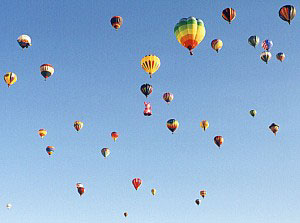If you're a complete beginner
to the entire ballooning experience, there's a world to learn about
this most beautiful way to fly.
Preparing
for flight
The balloon is prepared by
spreading the envelope (the big fabric portion) out on the ground,
with the basket attached to it and lying over on its side. A
gasoline-powered fan is normally used to inflate the balloon with
cold air until it is packed full, and then the propane burners are
ignited to heat the balloon up. At this point, the balloon will
slowly stand up, and then it's the ground crews' job to hold the
basket down with their collective weight while the pilot continues
his preflight checks and boards passengers. When all is ready to go,
the pilot gives his crew the signal for "weight off," and
with a few more blasts of the burner, takes to the sky!
So,
how does all this work?
Basically, a balloon flies
because the air inside the envelope is hotter than the air outside
(known as ambient air). Although some people prefer more technical
explanations, it really is that simple! The burners heat the air
inside and allow the pilot to control the rate of ascent &
descent. When it's time to come down, the pilot can either let the
air in the envelope cool off on its own, or he can open a vent at
the top of the balloon to let some air out - either way works. When
it's time to land, the pilot will open the deflation port all the
way to spill the air out the top and deflate the balloon. The
balloon will then lay on its side and patiently wait to be packed up
by the pilot and crew.
 |
| Lots
of Balloons! |
Who
can fly a Balloon?
Well, anyone can fly in
a balloon, but to fly one you must become an F.A.A.-licensed balloon
pilot :)
How
do I become a pilot?
First "official"
thing to do is to apply for a Student Pilots' certificate which is
needed to be able to make your solo flight and later flight tests
with an examiner. To be a student pilot, you must be at least 14
years old and understand the English language, among other minor
things.
You might have already received
and logged some ground and flight instruction at this point, but if
not, what are you waiting for?
The next phase is to find an
instructor willing to teach you. Any commercial balloon pilot in the
U.S. has the privileges of acting as balloon flight instructor, so
there will be a number of pilots to help you get on your way.
Training involves at least 10
hours of flight instruction, passing a written knowledge test,
extensive ground instruction, and finally passing a flight
examination with an F.A.A. inspector (also known as a Practical
Test). Pass that, and you'll be granted your Private Pilot's
Certificate for Hot Air Balloons!
A private pilots' certificate
allows you to take passengers up, but to be able to operate for
hire, you must earn your Commercial hot air balloon pilots'
certificate. This involves at least 35 hours of flight time and a
much more stringent and demanding flight test.
How
can I get involved?
Easy! Find a balloon pilot near
you and give him or her a call or email. Most pilots will be
delighted to have you come out and get involved the next time they
go flying. The more help, the merrier!
I'm
ready to go!

